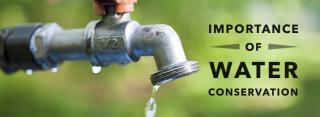Water Conservation

Water Conservation Tips and Tricks
Water is a precious commodity which we all take for granted. It is imperative that we all use water wisely and teach future generations to do the same. Uxbridge’s Water Conservation efforts help maintain our water demand comfortably below the water supply system’s safe yield (0.93 million gallons per day). Our current 5-year average water demand is approximately 0.696 million gallons per day. Tips and information on how to save water at home are linked below.
The Massachusetts Department of Environmental Protection (DEP) requires restrictions to be enacted on the amount and frequency of outdoor water use on a yearly basis. Our Water Management Act Permit requires mandatory seasonal water use restrictions for nonessential outdoor water usage. As such, all citizens of Uxbridge should be cognizant that the opportunity to water lawns may be restricted. Please refer to the website to see the current restrictions in place.
The following are excellent idea on ways to conserve water and there are a number of websites you may connect to for further information on water conversation and landscaping techniques you may use.
Tips for Saving Water in the Home
In The Bathroom
- Check your toilets for leaks. Put a little food coloring in your toilet tank. If, without flushing, the color begins to appear in the bowl, you have a leak that should be repaired immediately.
- Check Faucets and pipes for leaks. The smallest drip from a worn washer can waste 20 or more gallons a day. Larger leaks can waste hundreds.
- Replace your old toilet with a low-flow toilet. Ultra low-flow toilets use no more than 1.6 gallons per flush. Old toilets use six gallons per flush.
- Do not use the toilet as an ash tray or wastebasket.
- If you have an older toilet, place an inch of sand in a quart size bottle, fill it with water, and place it in the tank away from operating mechanism. You can save five or more gallons a day.
- Install water-saving shower heads or flow restrictors. Your local hardware or plumbing supply store stocks inexpensive items to install fixtures.
- Turn off the water while shaving or brushing your teeth.
In the Kitchen and Laundry
- Use your washing machine and dishwasher only for full loads.
- Check faucets and pipes for leaks.
- If you wash dishes by hand, do not leave the water running.
- Use garbage disposal less often.
- Do not let the faucet run while cleaning vegetables.
- Keep a bottle of drinking water in the refrigerator.
Outdoors
Most outdoor water waste occurs through water-intensive landscaping and improper outdoor watering.
- Check for leaks in pipes, hoses, faucets and couplings. Check frequently and keep them drip-free.
- Water your lawn only when needed. A good way to see your lawn needs watering is to step on the grass. If it springs back up when you move, it does not need water.
- Most lawns need only 1″ water per week. Water deeply, less often (twice per week). Deep watering encourages healthy root growth. DO NOT WATER EVERY DAY! In general, rotor heads deliver ½ inch of water per hour. For ¼ inch of water, run the sprinkler 20 to 30 minutes This means one hour twice per week is the best way to set your irrigation system.
- Water between 2 a.m. and 6 a.m. for minimal evaporation. Water in the evening can promote fungus growth.
- Make sure you are watering your yard and not the driveway or street.
- Use a broom instead of a hose to clean driveways and sidewalks.
- Wash your car with a bucket of soapy water using the hose only to rinse.
- Do not let children play with the hose or sprinkler.
- Install a properly designed irrigation system with a moisture sensor.
- Decrease your turf area to 25 percent of your yard. Increase mulched beds, trees, vines and ground-covered areas to 75 percent.
- Mulch, mulch, mulch! Mulch retains moisture, cools the ground and decreases the need for watering.
- Mow your grass at the right height. The higher the better in summer months (at least three plus inches high).
- Select plants that are native to the area, have low water needs and are shade producing.
- Install a rain gauge in your lawn to measure when your grass actually needs watering.
The following websites will offer additional conservation information:
- Massachusetts Department of Agricultural Resources - Water Use and Water Conservation
- Massachusetts Water Resources Commission - Indoor Water Conservation
- EPA - Water Conservation Tips for Residents
- EPA WaterSense
- Indoor Water Conservation Tips
- UMass Listing of Drought Tolerant Plantings
- 10 Ways to Save Water at Home
- FEMA Water Conservation Tips
